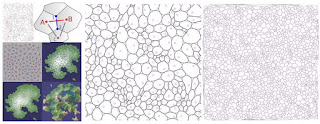The intention of my 800 project is to test an old-school
Vortex-Knot-Atoms theory of everything,
... and my approach is that of a dynamic-foam,
... wherein Torus-, Trefoil- and fig. 8-knots can self-emerge and interact.
-
I've been focusing on a Triangle-Mesh & Fluid-Grid combination; but now I’ve realised that such a setup is too complicated to begin with. A Reaction-Diffusion & Fluid-Grid combination might be the best way to go.
-
Here's a summery that outlines the idea of a dynamic foam which has 3 phases of matter:
• Solid volumes : A, B, C, D, ...
• Gas between those volumes that forms a circuit : ac, bc, cd, ...
• Phase-transitioning from Solid < > Gas : acAD, bcAB, cdBD, …
Pressure and tension in the pathways, and between the bubbles organise the flow. Currents can block each other or merge. The temperature in the network makes some volumes heat-up and expand; while others cool-down and shrink.
To take it to the next level the above particle model could be replaced by a Reaction Diffusion grid, boosted with a CFD-fluid and a couple of extras.
-
The idea for using a grid came from this circle-drawing article:
... and Robert Munafo’s Reaction Diffusion 'Gray-Scott Explorer':
A first extra tool would be a Voronoi-fields generator like in this example:
• A Poisson distribution of Volumes.
• Gradually expand the temperature of the Volumes.
• Where the circular volumes clash/overlap there is a pressure change -> gas creation and cell formation.
• At a tipping point all gas-canals connect and currents can start to flow around and form circuits.
Gas forms where the changing temperatures in the medium clash:
The second part is your fluid dynamics model for the current network between the volumes.
In general we get 3 zones:
• Solid cell-Volumes with internal temperature like RD models.
• Fee moving Gas can form fast currents between the Volumes and carry heat, like CFD.
• Phase-transition (RD): Cells can vaporise and Gas can condensate.
Sliders will be needed to fine-tune the phase-change, and the properties of the Cells and Gas.
With ultimately as goal to create steady fluctuations within the foam, where the heated circuits make some cells expand and others cool down and shrink.
Similar to
Game of Life where cells live or die, forming pulsating ‘organisms'.
-
The goal is now to combine two models:
• Reaction-Diffusion:
Such as
Gray-Scott Explorer, that uses uses only two chemicals described by the two partial differential equations (PDEs):
• Fluid:
The Navier-Stokes Equations for the velocity in a compact vector notation (top) and the equation for a density moving through the velocity field (bottom).
Jos Stam's fluid model uses 'classical' Brownian Motion diffusion:














































